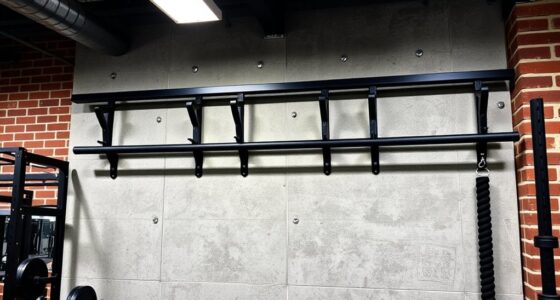I’ve found the top 15 smart home hubs of 2025 that support a wide range of protocols like Zigbee, Thread, Bluetooth, and Wi-Fi, ensuring seamless control over numerous devices. They work with major voice assistants and popular ecosystems such as Apple HomeKit, SmartThings, and OpenHAB, making setup easy and flexible. If you want an all-encompassing system that scales and integrates smoothly, these hubs are worth exploring further. Keep going to discover all the features that set them apart.
Key Takeaways
- Support for multiple protocols (Zigbee, Z-Wave, Wi-Fi, Bluetooth, IR, RF) ensures broad device compatibility and seamless integration.
- Compatibility with major platforms like Apple HomeKit, Alexa, Google Assistant, and SmartThings enables versatile voice and app control.
- Easy setup through apps or plug-and-play options simplifies installation for both beginners and advanced users.
- Advanced features such as scene creation, device grouping, and DIY automation enhance user customization.
- Reliable connectivity, expanded device management, and local control options provide stability and privacy in smart home ecosystems.
Coulisse MotionBlinds Wi-fi Bridge Smart Home Gateway Hub

If you’re looking for a smart home hub that simplifies controlling window coverings, the Coulisse MotionBlinds Wi-Fi Bridge (CM-20) is a great choice. It offers extensive control via the MOTION app, allowing you to operate blinds, shades, and other coverings effortlessly. Compatible with various wired and battery-powered motors, it fits residential, commercial, and hospitality settings. The device connects seamlessly with smart platforms like Alexa, Google Assistant, and SmartThings for voice commands and automation. Its sleek, minimal design makes setup quick and cable-free, with local data storage to enhance privacy. Overall, it’s a versatile hub for smarter window management.
Best For: homeowners and professionals seeking an easy-to-install, versatile smart home hub for automating window coverings with voice control and privacy-focused data storage.
Pros:
- Supports a wide range of wired and battery-powered motors, suitable for various environments
- Seamless integration with popular smart platforms like Alexa, Google Assistant, and SmartThings
- Easy, cable-free setup with local data storage enhancing user privacy
Cons:
- Customer reviews mention difficulties with customer support and system complexity
- Not water-resistant, limiting outdoor or moisture-prone installation options
- Some users find the system costly and challenging to troubleshoot without assistance
Smart Hub Gateway for Smart Home Control
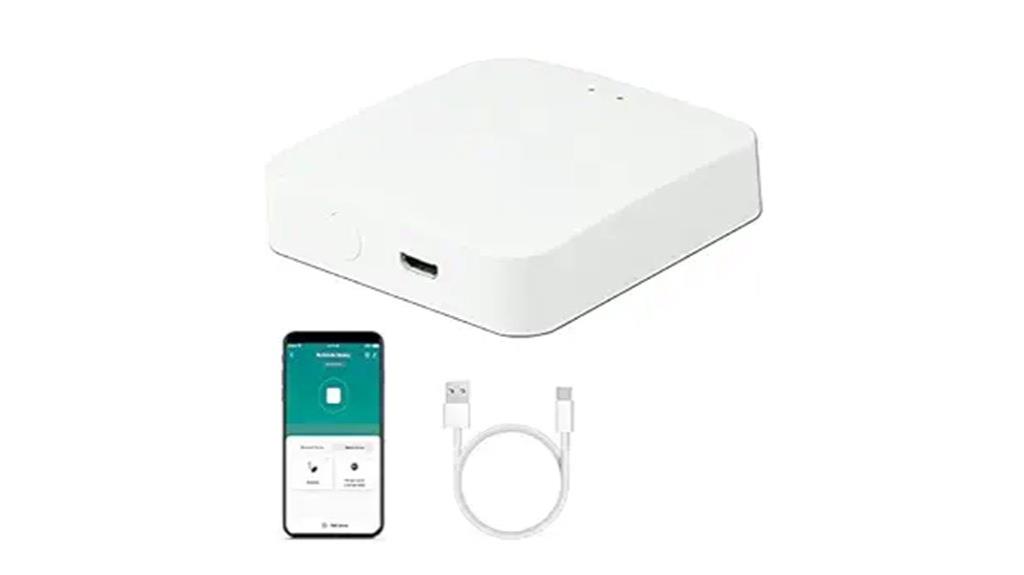
The Smart Hub Gateway stands out as an excellent choice for those seeking a versatile and reliable control center for their smart home. It supports Zigbee, Bluetooth Mesh, and Wi-Fi simultaneously, allowing management of up to 128 devices through the Smart Life App. Its stable, secure connection improves over Wi-Fi-only systems and enables whole-house device linkage, scene creation, and grouping. Setup is quick and straightforward, with the app automatically detecting devices and updating firmware. Compatible with Amazon Alexa, Google Assistant, and Siri, it offers seamless voice control. Despite some connectivity issues reported by users, its affordability and multi-protocol support make it a practical hub for building an intelligent ecosystem.
Best For: smart home enthusiasts seeking a versatile, multi-protocol hub to manage numerous devices with easy setup and voice control integration.
Pros:
- Supports Zigbee, Bluetooth Mesh, and Wi-Fi simultaneously for broad device compatibility
- Easy and quick setup with automatic device detection and firmware updates
- Compatible with Alexa, Google Assistant, and Siri for seamless voice control
Cons:
- Some users experience limited reception distance and slow response times
- Inconsistent connectivity with certain Zigbee devices like switches and locks
- Reports of build quality issues and occasional connection drops
Smart Multi-mode Gateway for Smart Home (ZigBee 3.0, Bluetooth & Mesh)
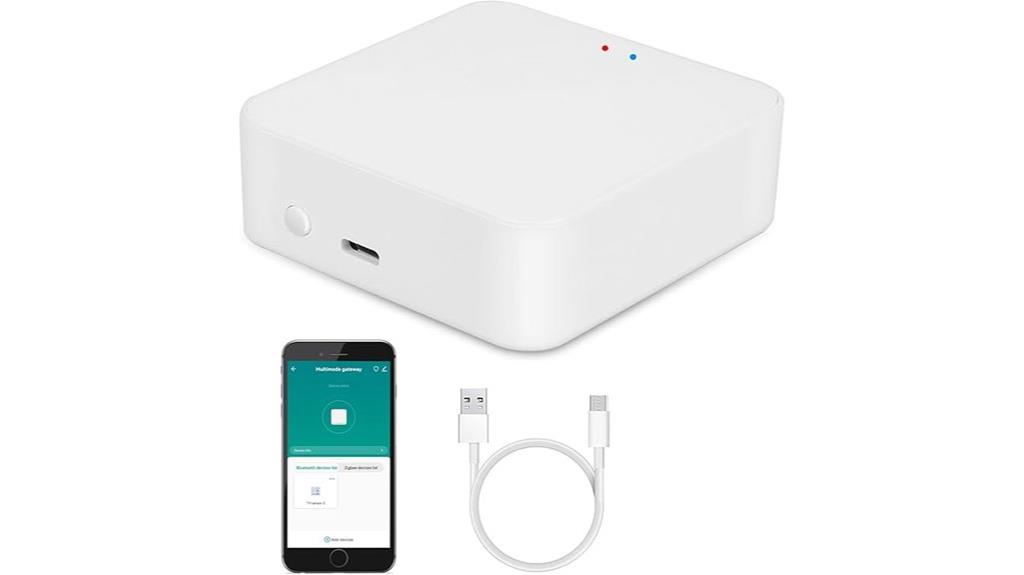
For anyone looking to unify their smart home devices under a single control center, the Smart Multi-mode Gateway stands out thanks to its support for ZigBee 3.0, Bluetooth Mesh, and Wi-Fi. It serves as an all-in-one hub, compatible with up to 128 Tuya/SmartLife devices like sensors, leak detectors, and Finger Bots. Easy to set up with just a power connection, it offers seamless device management via the Tuya Smart or Smart Life app. With multi-protocol support, it ensures reliable connectivity across your ecosystem. Plus, voice control via Alexa and Google Home adds convenience, making your smart home smarter and more integrated.
Best For: smart home enthusiasts seeking a versatile and easy-to-setup central hub to unify their ZigBee, Bluetooth, and Wi-Fi devices within a single ecosystem.
Pros:
- Supports multiple protocols (ZigBee 3.0, Bluetooth Mesh, Wi-Fi) for broad device compatibility.
- Simple installation with just a power connection, no network cable required.
- Compatible with Tuya/SmartLife devices and controllable via popular apps and voice assistants.
Cons:
- Some users report limited device compatibility and occasional connectivity issues.
- Requires specific Tuya/SmartLife devices for optimal functionality.
- Slightly limited range due to reliance on 2.4GHz network and device size.
Matter Smart Home Hub, Thread & Tuya Zigbee 3.0
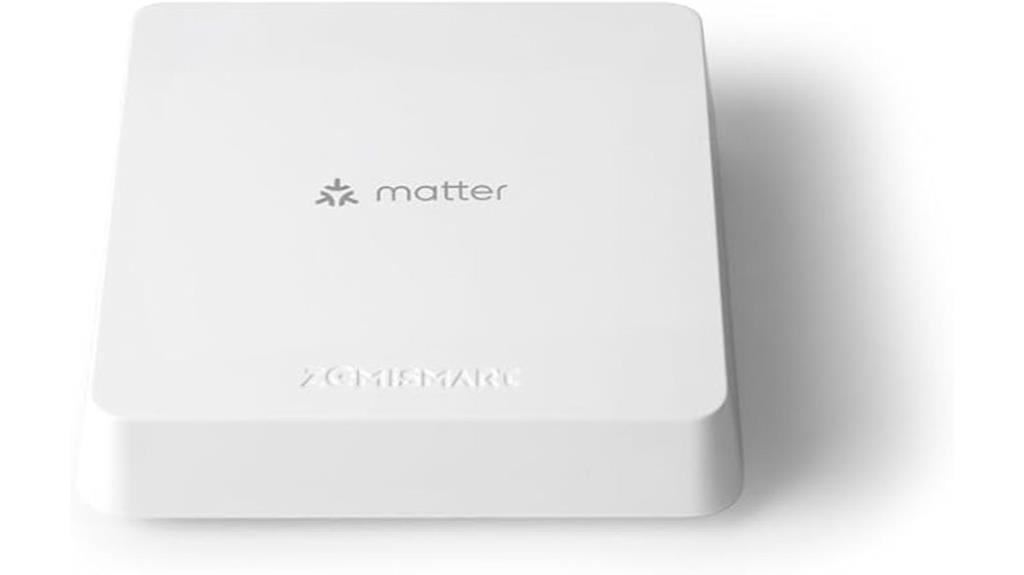
A Matter Smart Home Hub that supports Thread and Tuya Zigbee 3.0 offers a versatile solution for smart home enthusiasts looking to integrate multiple protocols seamlessly. I find it ideal for managing Tuya Zigbee devices and Thread-compatible gadgets, though not all Zigbee devices are guaranteed compatibility. Its multi-platform control via Tuya, Smart Life, Google Home, and Apple HomeKit makes remote access easy. Setup is straightforward, but some users experience issues with device addition or Thread support without extra hardware. Overall, it’s an economical option that enhances smart home connectivity, especially with Tuya devices, though occasional troubleshooting may be necessary for most effective performance.
Best For: smart home enthusiasts seeking a versatile hub to manage Tuya Zigbee and Thread devices with multi-platform control and easy setup.
Pros:
- Supports multiple protocols including Zigbee 3.0, Thread, and Tuya standards for broad device compatibility
- Compatible with major platforms like Apple HomeKit, Google Home, Smart Life, and Amazon Alexa for remote control
- Compact design with simple setup process and no included power adapter, reducing initial costs
Cons:
- Not all Zigbee devices, especially non-Tuya or Thread gadgets, are fully compatible or easily added
- Some users experience issues with Thread device integration or accessory pairing without additional hardware or firmware updates
- Limited Thread support without extra hardware like a border router; firmware and app limitations may affect device performance
Broadlink RM MAX Smart Home Hub, Wi-Fi & BLE Remote for IR/RF Devices
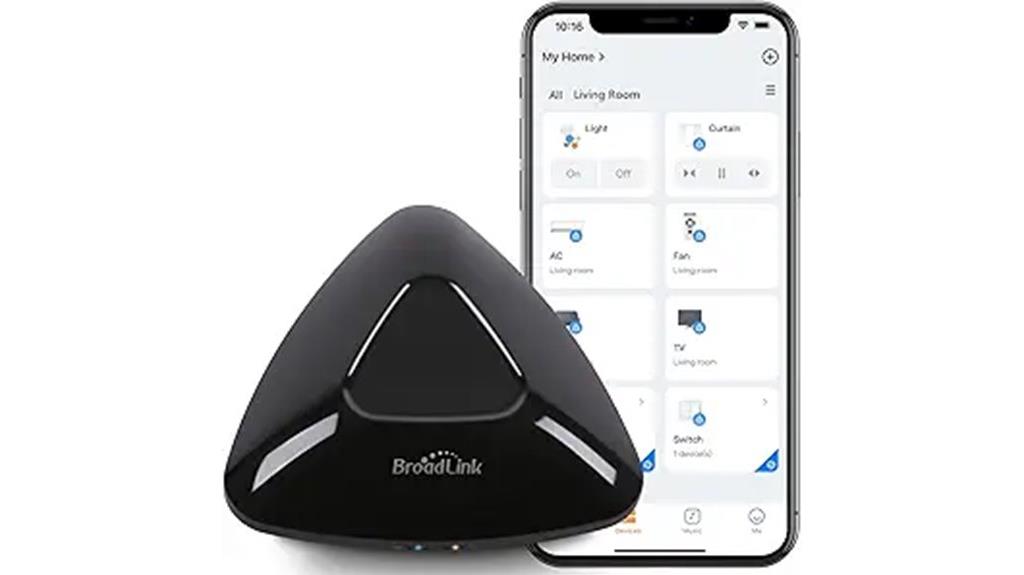
If you’re looking for a versatile smart home hub that can control a wide range of devices, the Broadlink RM MAX stands out with its combined Wi-Fi and BLE connectivity. It supports IR (38KHz) and RF (433MHz), making it perfect for managing TVs, air conditioners, fans, blinds, and switches. Easy to set up via the Broadlink Magic Home app, it offers quick device discovery and local control—even during internet outages. You can create routines and scenes for automation, and it works seamlessly with Alexa and Google Home for voice commands. Compact and powerful, the RM MAX simplifies multi-device control and enhances your smart home experience.
Best For: smart home enthusiasts seeking a versatile hub that supports IR and RF devices with reliable local control and voice assistant integration.
Pros:
- Supports IR (38KHz) and RF (433MHz) for wide device compatibility
- Offers fast device discovery and local control via Wi-Fi and BLE, even during internet outages
- Compatible with Alexa and Google Home for effortless voice command integration
Cons:
- Slightly larger in size, which may impact placement options
- Requires the Broadlink Magic Home app for setup, which may involve a learning curve for some users
- Limited to specific RF frequencies (433MHz), so may not support all RF devices
Tuya Smart Multi-Mode Gateway for Home Automation

The Tuya Smart Multi-Mode Gateway stands out for its versatile multi-protocol support, making it ideal for those seeking a reliable, all-in-one hub for their smart home. Supporting Zigbee 3.0, BLE, and Bluetooth Mesh, it seamlessly connects a wide range of devices like sensors, switches, and lights. Compatible with Alexa, Google Assistant, and Siri, it offers voice control, while the Smart Life app enables remote management of up to 128 devices. Its compact design, low power consumption, and stable connectivity make it perfect for indoor use. Overall, it’s an affordable, user-friendly option that simplifies home automation through reliable multi-protocol integration.
Best For: homeowners seeking an affordable, easy-to-use multi-protocol hub to integrate and control a variety of smart home devices seamlessly.
Pros:
- Supports multiple protocols (Zigbee 3.0, BLE, Bluetooth Mesh) for broad device compatibility
- Compatible with major voice assistants like Alexa, Google Assistant, and Siri for easy voice control
- Compact, low-power design with reliable indoor connectivity and simple app setup
Cons:
- Limited to 2.4GHz WiFi, requiring a stable network connection for operation
- Range may be restricted in larger spaces, possibly necessitating additional hubs or extenders
- Some users may need an adapter for connecting certain Zigbee devices
WiFi Universal IR Remote Control, Tuya Smart Hub 360° Remote, Alexa & Google Compatible
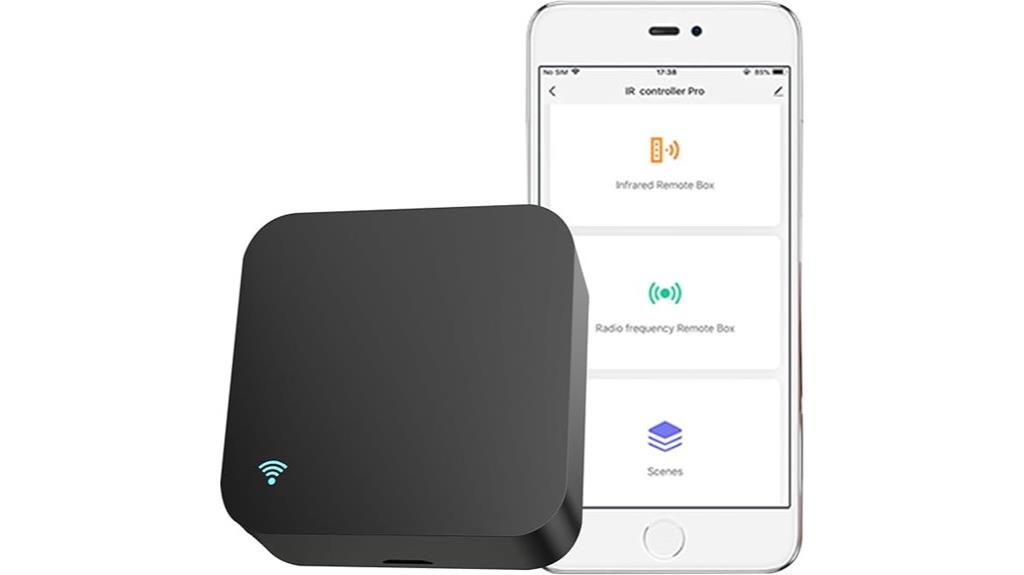
For those seeking seamless home automation, the WiFi Universal IR Remote Control, Tuya Smart Hub, and 360° Remote stand out as an excellent choice, especially since it’s compatible with Alexa and Google Assistant. It controls TVs, air conditioners, fans, and more, supporting multi-scenario setups indoors and outdoors. You can customize commands via the Yatu Smart App or learn functions from existing remotes. Its stable sensors guarantee smooth automation across rooms. Powered by USB, it offers hands-free voice control, making device management effortless. Despite some durability concerns, users appreciate its affordability and ease of setup, making it a versatile addition to any smart home system.
Best For: homeowners and tech enthusiasts seeking an affordable, easy-to-setup smart remote that integrates with Alexa and Google for seamless device control.
Pros:
- Compatible with Alexa and Google Assistant for voice-activated control
- Supports DIY learning to replicate functions from existing remotes
- Easy setup with the Yatu Smart App and stable sensors for reliable automation
Cons:
- Durability issues reported by some users
- Limited to 2.4G WiFi networks, not compatible with 5G
- Slightly higher price point for basic remote functions compared to traditional remotes
TP-Link Tapo Smart Plug Outlet Extender
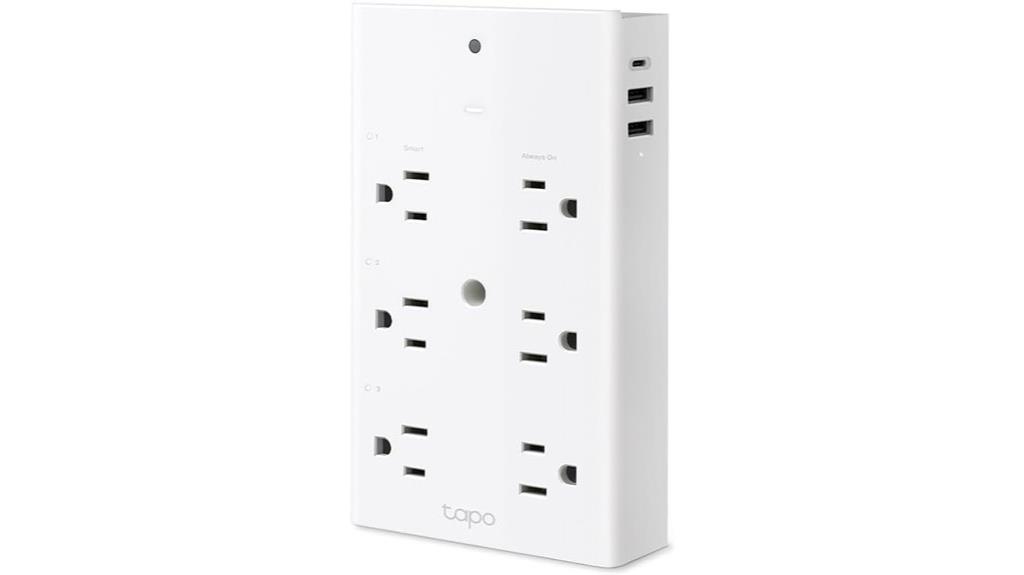
The TP-Link Tapo Smart Plug Outlet Extender stands out as an excellent choice for those seeking versatile power management with smart home integration. It transforms a standard outlet into a multi-functional hub with 9-in-1 features, including controllable outlets, always-on outlets, and fast-charging USB ports. Compatible with Apple HomeKit, Alexa, and Google, it offers seamless voice and app control. Its wide-spaced outlets accommodate large plugs, and safety features like surge protection and heat dissipation ensure reliable operation. Easy to install and manage, the Tapo P306 combines convenience, safety, and smart home compatibility, making it a robust addition for expanding your connected home in 2025.
Best For: homeowners and tech enthusiasts seeking a versatile, reliable smart outlet extender with integrated USB charging and smart home compatibility.
Pros:
- Seamless integration with Apple HomeKit, Alexa, and Google Home for easy voice and app control
- 9-in-1 functionality with controllable outlets, always-on outlets, and fast-charging USB ports
- Wide-spaced outlets and built-in night light for convenience and safety
Cons:
- Slightly bulky design may be less discreet in some spaces
- Limited surge protection (205 joules) with no indicator when compromised
- Connectivity issues with certain mesh networks like TP-Link Deco, requiring workaround solutions
MOES Tuya ZigBee 3.0 Hub/Wired Gateway, WiFi Smart Home Bridge
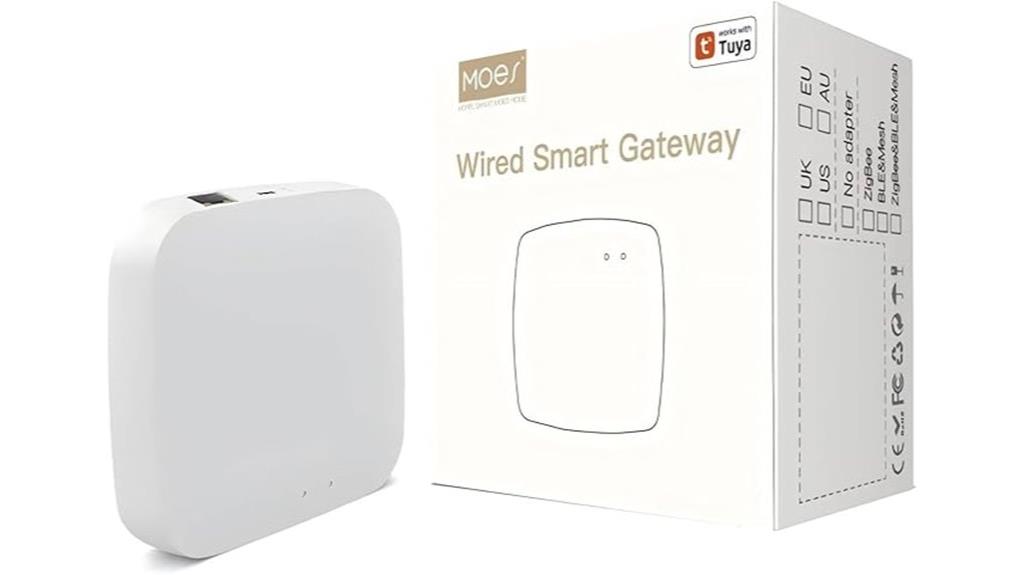
If you’re looking for a compact and affordable smart home hub that offers reliable ZigBee connectivity, the MOES Tuya ZigBee 3.0 Hub is an excellent choice. Weighing just 5 ounces, it connects easily to WiFi routers and supports over 200 meters of coverage. It can manage up to 20 devices, including lights, sensors, and plugs, and integrates seamlessly with platforms like SmartLife, Google Home, and Home Assistant. Powered via USB, it’s simple to set up and expand your smart ecosystem. While some users experience minor disconnects or bright LEDs, overall, it offers stable performance and good value for expanding smart home control in 2025.
Best For: DIY smart home enthusiasts seeking a reliable, affordable ZigBee hub to expand and integrate multiple smart devices across various platforms.
Pros:
- Easy to set up and connect via USB with seamless WiFi integration
- Supports over 200 meters of coverage and up to 20 devices
- Compatible with popular platforms like SmartLife, Google Home, and Home Assistant
Cons:
- Bright activity LEDs with no option to turn off, which can be distracting
- Occasional connectivity issues such as device disconnects
- Limited ZigBee device compatibility and higher price point compared to some alternatives
Aqara Smart Hub M3 for Home Automation
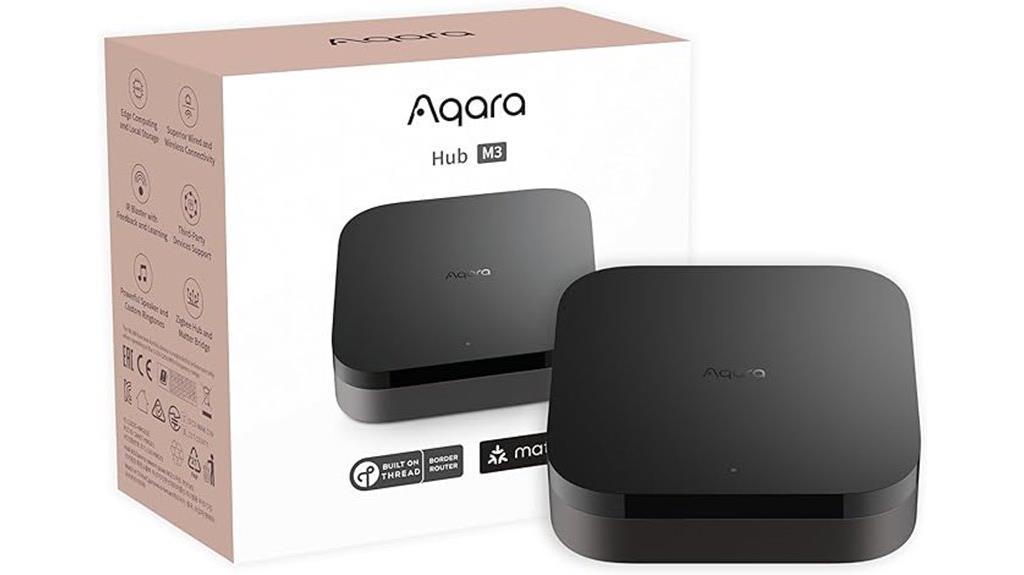
Aqara Smart Hub M3 stands out as a top choice for those seeking robust device connectivity and local automation control. It supports Zigbee, Thread, Wi-Fi, Bluetooth, IR, and PoE, enabling connection with numerous devices and ecosystems like Apple HomeKit, Alexa, and SmartThings. The hub functions as a Matter controller and border router, ensuring seamless integration with third-party devices. It prioritizes local control with 8GB encrypted storage and features like a smart IR blaster, temperature sensors, and flexible placement options. While setup is quick and reliable, some limitations include range constraints, compatibility issues with certain devices, and a higher price point for coverage.
Best For: Homeowners seeking a versatile, local-control smart hub that supports multiple ecosystems and extensive device connectivity.
Pros:
- Supports a wide range of protocols including Zigbee, Thread, Wi-Fi, Bluetooth, IR, and PoE for comprehensive device compatibility
- Prioritizes local automation with encrypted storage, ensuring privacy and stability without relying solely on cloud services
- Easy and quick setup with features like Magic Pair for seamless device pairing
Cons:
- Limited range of approximately 60-65 feet, which may require additional hubs or extenders in larger homes
- Compatibility issues with some third-party devices and remote controls, necessitating alternative solutions or firmware updates
- Higher price point relative to coverage area and some users experience instability with Apple HomePod integration
Zigbee 3.0 US B Dongle Gateway
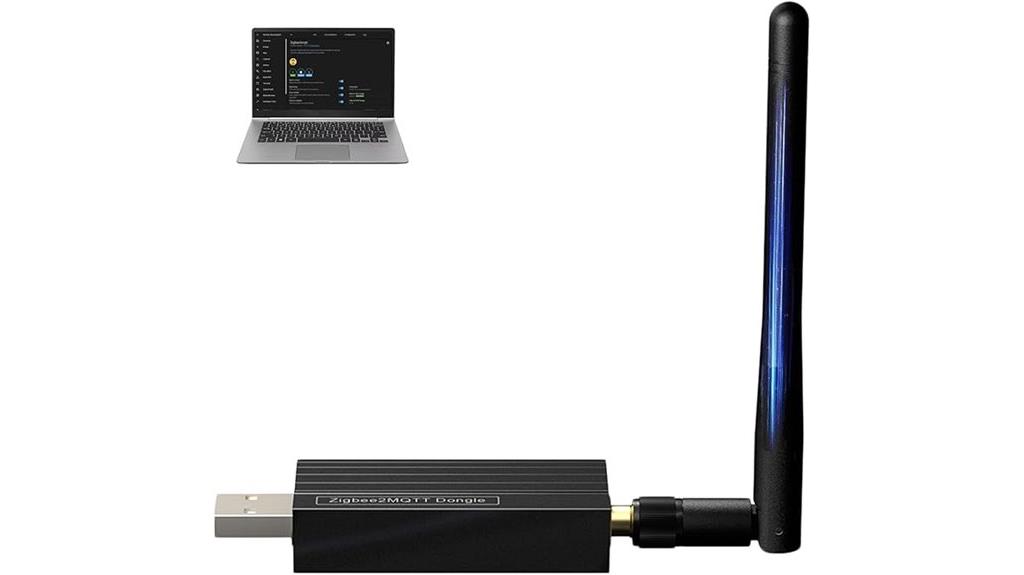
For smart homeowners seeking reliable, versatile connectivity, the Zigbee 3.0 USB Dongle Gateway stands out as an excellent choice. It features Z-Stack 3.x.0 firmware, requiring no manual flashing, and works seamlessly with platforms like Home Assistant, ZigBee2MQTT, and OpenHAB. Compatible with ZigBee 3.0 devices, it manages sensors, locks, switches, and bulbs across brands. Equipped with high-performance chips (90CC2652P CP2102N) and 20dBm output gain, it offers strong signal coverage and stability. Its plug-and-play design, USB antenna, and support for WiFi adapters make setup straightforward, ensuring quick, reliable control of your smart home devices.
Best For: smart homeowners seeking a reliable, easy-to-setup Zigbee gateway that supports diverse devices and platforms for seamless home automation.
Pros:
- Plug-and-play setup with no manual firmware flashing required
- Supports multiple open-source smart home platforms like Home Assistant, ZigBee2MQTT, and OpenHAB
- High signal strength and stability thanks to advanced chips and 20dBm output gain
Cons:
- Requires a compatible computer, VPS, or Linux server for operation
- Limited to ZigBee 3.0 devices; incompatible with older ZigBee standards
- May need additional WiFi adapters for integrated network versatility
USB C Docking Station with Dual Monitors and Multiport Adapter
https://m.media-amazon.com/images/I/71w0o0K0eCL._AC_SX679_.jpg
The USB C Docking Station with Dual Monitors and Multiport Adapter stands out as an essential tool for professionals needing a seamless multi-screen setup and reliable connectivity on-the-go. It supports triple monitor setups with 4K60Hz HDMI and DisplayPort outputs, plus 100W PD charging to keep your laptop powered. Compatible with USB-C and Thunderbolt 3/4 laptops, it works with MacBook Pro, Dell XPS, Lenovo Yoga, and more. The dock offers multiple USB-A and USB-C ports for peripherals, gigabit Ethernet, SD card slots, and fast data transfer. Its compact design and stable connections make it perfect for home, office, or travel.
Best For: professionals and remote workers who need a versatile, multi-monitor setup with reliable connectivity and fast charging capabilities on their laptops.
Pros:
- Supports triple monitor setup with 4K60Hz resolution on each display, ideal for multitasking.
- Provides 100W PD charging, ensuring your laptop stays powered during use.
- Compact design with multiple ports including HDMI, DisplayPort, USB-A, USB-C, Ethernet, and SD card slots for extensive device connectivity.
Cons:
- Some users report loose or defective ports leading to connection issues.
- Occasional overheating and driver compatibility problems can affect performance.
- Hardware failures and display refresh issues have been noted after prolonged use by certain users.
SmartThings Hub 3rd Generation Smart Home Automation Hub
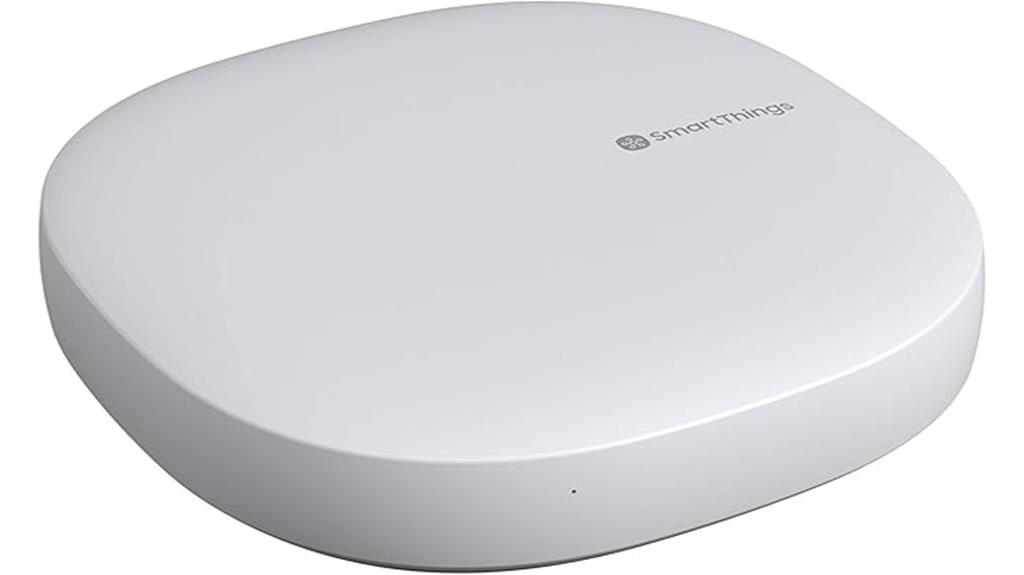
If you’re looking for a versatile hub that seamlessly integrates a wide range of smart devices, the SmartThings Hub 3rd Generation stands out as an excellent choice. It supports Zigbee, Z-Wave, Wi-Fi, and Ethernet, connecting devices like sensors, lights, thermostats, and plugs, including brands like Philips Hue and Meross. Easy to set up with a QR code, it offers local control for quick responses and reliability. Compatible with Alexa, Google Home, and Cortana, it allows voice commands and automation. Its compact design, reliable performance, and support for third-party devices make it a top pick for a thorough smart home ecosystem.
Best For: smart home enthusiasts seeking a versatile, reliable hub that supports a wide range of third-party devices and voice assistants for seamless automation and local control.
Pros:
- Supports multiple protocols including Zigbee, Z-Wave, Wi-Fi, and Ethernet for extensive device compatibility
- Provides local control for faster response times and increased reliability without relying solely on cloud services
- Easy setup with QR code pairing and a user-friendly app interface, ideal for both beginners and advanced users
Cons:
- Designed primarily for indoor use, with an IP54 rating that offers limited water and dust protection
- Requires external power supply and does not include batteries, which may be less convenient for certain placements
- Compatibility may vary in regions due to power adapter differences; some users may need converters
SONOFF Zigbee Bridge Pro Hub, ZigBee 3.0 Smart Gateway
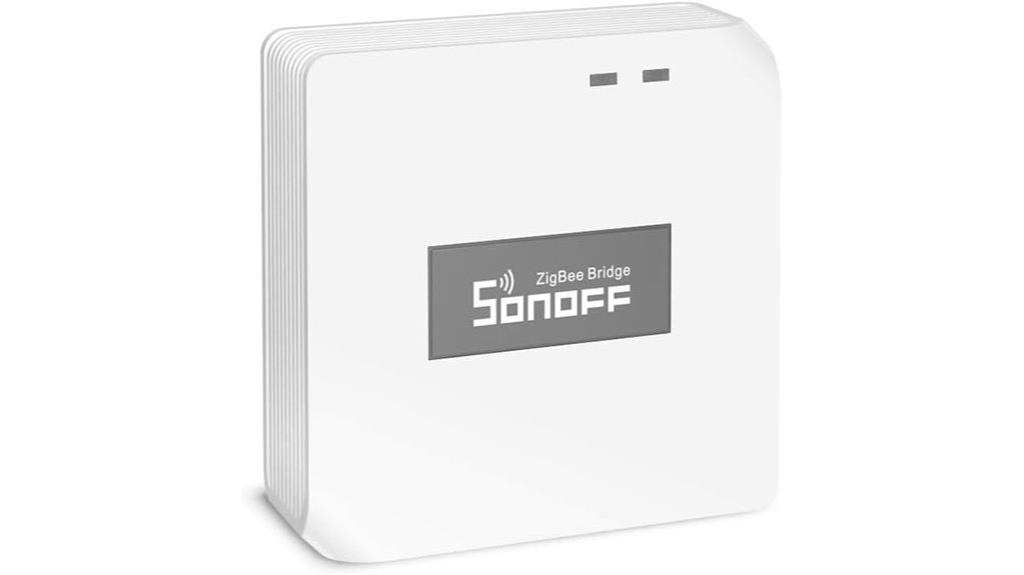
With support for up to 128 Zigbee devices and dual Wi-Fi & Zigbee communication, the SONOFF Zigbee Bridge Pro Hub stands out as an excellent choice for small homes, apartments, or farm setups seeking reliable, extensive smart home management. It’s compatible with SONOFF Zigbee devices like smart switches, plugs, and sensors, and supports local scene control even if the network disconnects. Its compact design, easy setup, and stable performance make it a popular choice. While it has some limitations with non-SONOFF Zigbee products, its mesh-extending capabilities and firmware updates guarantee a seamless, integrated smart home experience for most users.
Best For: small homes, apartments, or farm setups seeking reliable, extensive smart home management with SONOFF Zigbee devices and dual Wi-Fi & Zigbee communication.
Pros:
- Supports up to 128 Zigbee devices, allowing extensive smart home networks
- Compatible with SONOFF Zigbee products and extends Zigbee mesh for better range and stability
- Easy to install, compact design, and stable performance with firmware updates
Cons:
- Limited compatibility with non-SONOFF Zigbee devices like Aqara sensors and door locks
- Requires LAN connectivity for full device functionality, limiting isolated network use
- Some advanced third-party Zigbee device configurations may be challenging or limited
ZigBee & Bluetooth Mesh Gateway Hub, Tuya Smart Hub with Voice Control

For anyone seeking a versatile smart home hub that supports multiple protocols, the Tuya Smart Hub with Voice Control stands out. It supports Bluetooth 5.0, ZigBee 3.0, and 2.4G Wi-Fi, acting as a bridge for up to 128 Tuya-compatible devices like sensors, lights, and switches. It enables seamless automation across ZigBee, Bluetooth, and Wi-Fi devices, making your smart home truly integrated. Controlled via the Tuya Smart Life app, it also works with Alexa and Google Home for voice commands. Its compact design is easy to set up, though some users report occasional connectivity hiccups. Overall, it’s a flexible, user-friendly hub for multi-protocol smart homes.
Best For: smart home enthusiasts seeking a versatile, multi-protocol hub that seamlessly integrates ZigBee, Bluetooth, and Wi-Fi devices with voice control capabilities.
Pros:
- Supports multiple protocols (Bluetooth 5.0, ZigBee 3.0, 2.4G Wi-Fi) for broad device compatibility and reliable connections.
- Compatible with popular voice assistants like Alexa and Google Home for convenient voice control and automation.
- Compact and easy to set up, with user-friendly app management and device sharing features.
Cons:
- Some users experience intermittent connectivity issues, device resets, or pairing failures.
- Limited to 2.4G Wi-Fi; does not support 5G networks which may affect future-proofing.
- Mixed reviews on device stability and reliability, requiring troubleshooting or replacements for consistent performance.
Factors to Consider When Choosing Smart Home Hubs for Multi-Device Control
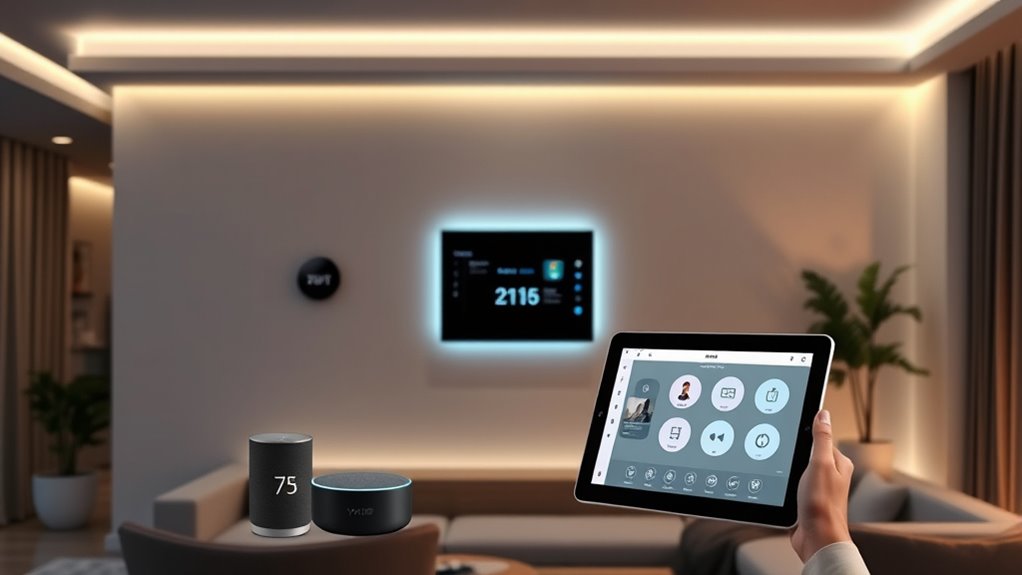
When choosing a smart home hub for multiple devices, I focus on protocol compatibility to guarantee my gadgets work seamlessly together. I also consider how easy it is to set up and control, along with the hub’s automation features and voice command support. These factors help me find a hub that simplifies managing my smart home efficiently.
Protocol Compatibility Range
Choosing a smart home hub that supports multiple communication protocols is essential for guaranteeing seamless device integration and reliable performance. You want to confirm it supports the protocols your current devices use, like Zigbee 3.0, Z-Wave, Thread, Bluetooth Mesh, or Wi-Fi. Multi-protocol hubs that combine Wi-Fi, Zigbee, and Bluetooth Mesh give you a broader range of compatible devices, reducing the need for multiple controllers. Compatibility with industry standards like Zigbee 3.0 and Thread also improves interoperability and future expandability. Additionally, check the hub’s maximum number of devices per protocol to ensure it can handle your setup now and later. A hub with diverse protocol support offers more reliable connectivity and minimizes issues caused by incompatible or outdated standards.
Device Ecosystem Support
Supporting the specific device ecosystems you use is vital for seamless smart home integration. I always check if a hub supports protocols like Zigbee, Z-Wave, Thread, BLE, or Wi-Fi, as this guarantees my devices work smoothly together. Compatibility with popular platforms such as Apple HomeKit, Google Home, Amazon Alexa, or SmartThings is also essential for broad control options. I verify whether the hub supports third-party standards or proprietary protocols because limited support can restrict device choices and future expandability. Scalability matters too—many hubs support from 20 up to 128 devices, so I consider my current and future needs. Finally, multi-protocol support, like Zigbee, Bluetooth, and Wi-Fi, helps me manage diverse device types within a unified system effortlessly.
Setup and Installation Ease
A smart home hub that’s easy to set up can save you time and frustration, making it more enjoyable to build your connected environment. Look for hubs with simple, plug-and-play or app-based configurations that require minimal wiring or technical skills. Clear, step-by-step instructions or guided tutorials are essential for quick, hassle-free installation. Wireless connection options like Wi-Fi, Zigbee, or Bluetooth simplify placement and reduce clutter, making setup more flexible. Choose a hub with an intuitive app that allows for easy device pairing, grouping, and automation, especially with automatic detection and firmware updates. finally, opt for models with minimal physical components and straightforward mounting options to cut down on installation time and complexity.
Automation and Control Features
When selecting a smart home hub, it’s vital to evaluate its automation and control features, as these determine how effectively you can manage multiple devices. I look for hubs that support multiple protocols like Zigbee, Z-Wave, Wi-Fi, and Bluetooth, ensuring smooth communication across various devices. Advanced automation tools such as scene creation, device grouping, and scheduling are essential for customizing routines and automating interactions based on time, location, or sensors. Compatibility with voice assistants like Alexa, Google Assistant, and Siri adds control flexibility, letting me activate scenes or devices by voice. Additionally, support for local control and automation means devices run reliably without internet, reducing lag and boosting privacy. Firmware updates and customizable rules further expand control options, making my smart home more adaptable and intuitive.
Voice Command Integration
Voice command integration plays a key role in how effectively a smart home hub manages multiple devices. Ensuring the hub supports popular voice assistants like Alexa, Google Assistant, or Siri is essential for seamless control. Compatibility with your specific devices and protocols—such as Zigbee, Z-Wave, or Bluetooth—also matters, so voice commands work across everything. I recommend checking if voice control features need extra setup, like activating skills or linking apps, to avoid surprises. Firmware updates are another factor; regular updates can improve voice recognition and add new features. Finally, reading user reviews helps gauge real-world performance, responsiveness, and reliability. A well-integrated voice system makes controlling your smart home intuitive and effortless, truly enhancing your experience.
Reliability and Connectivity
Choosing a reliable smart home hub hinges on its ability to support multiple communication protocols like Zigbee, Z-Wave, Wi-Fi, and Bluetooth, which guarantees broad device compatibility and stable connections. A strong connection depends on low latency and consistent signal strength, especially in larger or multi-floor homes. Firmware updates and manufacturer support are essential for fixing connectivity issues and keeping devices running smoothly over time. Features like mesh networking and dual-band Wi-Fi can markedly improve overall reliability by reducing disconnections. User reviews often highlight hubs with fewer dropped connections, quick pairing, and effective interference management as more dependable choices. Prioritizing these factors ensures your smart home remains responsive, stable, and capable of handling multiple devices seamlessly.
Frequently Asked Questions
How Do Smart Home Hubs Ensure Compatibility Across Various Device Brands?
Smart home hubs make sure different device brands work together by using universal protocols like Zigbee, Z-Wave, or Wi-Fi. I’ve found that hubs with multiple protocol support easily connect various gadgets, no matter the brand. They act as a central translator, allowing seamless communication. This compatibility effort means I can control all my devices from one app, making my smart home more integrated and user-friendly.
What Security Features Are Most Effective in Protecting Smart Home Networks?
Many believe smart home security is enough with passwords, but that’s not true. I’ve found that multi-layered protection is most effective, including strong encryption, regular firmware updates, and two-factor authentication. Firewalls and network segmentation also add extra safety. I always recommend keeping devices’ software current and using a dedicated network for your smart gadgets to prevent breaches and keep your home secure.
Can Smart Hubs Integrate With Existing Home Automation Systems?
You’re wondering if smart hubs can integrate with existing home automation systems, right? The good news is, many smart hubs are designed for compatibility, supporting popular platforms like Zigbee, Z-Wave, or Wi-Fi. I’ve found that choosing a hub with broad protocol support makes it easier to connect your current devices. Just check the specifications to verify it works seamlessly with your existing system, and you’re good to go.
How Do Firmware Updates Impact Device Connectivity and Performance?
Did you know that 85% of smart device issues are caused by outdated firmware? Firmware updates are vital because they improve connectivity and performance by fixing bugs and enhancing compatibility. When I update my devices regularly, I notice fewer disconnects and smoother operation. Skipping updates can leave your devices vulnerable and less responsive, so I always keep my firmware current to guarantee my smart home runs seamlessly and efficiently.
Are There Eco-Friendly or Energy-Saving Options for Smart Home Hubs?
You’re wondering if there are eco-friendly or energy-saving options for smart home hubs. I’ve found that many modern hubs come with power-efficient designs and low-energy modes to reduce consumption. Some also feature solar charging or use recyclable materials, making them more environmentally friendly. I recommend looking for hubs with Energy Star ratings or those that can be scheduled to turn off when not in use, helping you save energy effortlessly.
Conclusion
As I imagine my smart home seamlessly humming with connected devices, I realize choosing the right hub is like finding the perfect conductor for an orchestra. With the right hub, every device, from lights to security, plays in harmony, creating a symphony of convenience. So, whether it’s ZigBee, Thread, or Wi-Fi, pick the one that aligns with your vision of a truly smart, effortless home—a symphony waiting to unfold.





